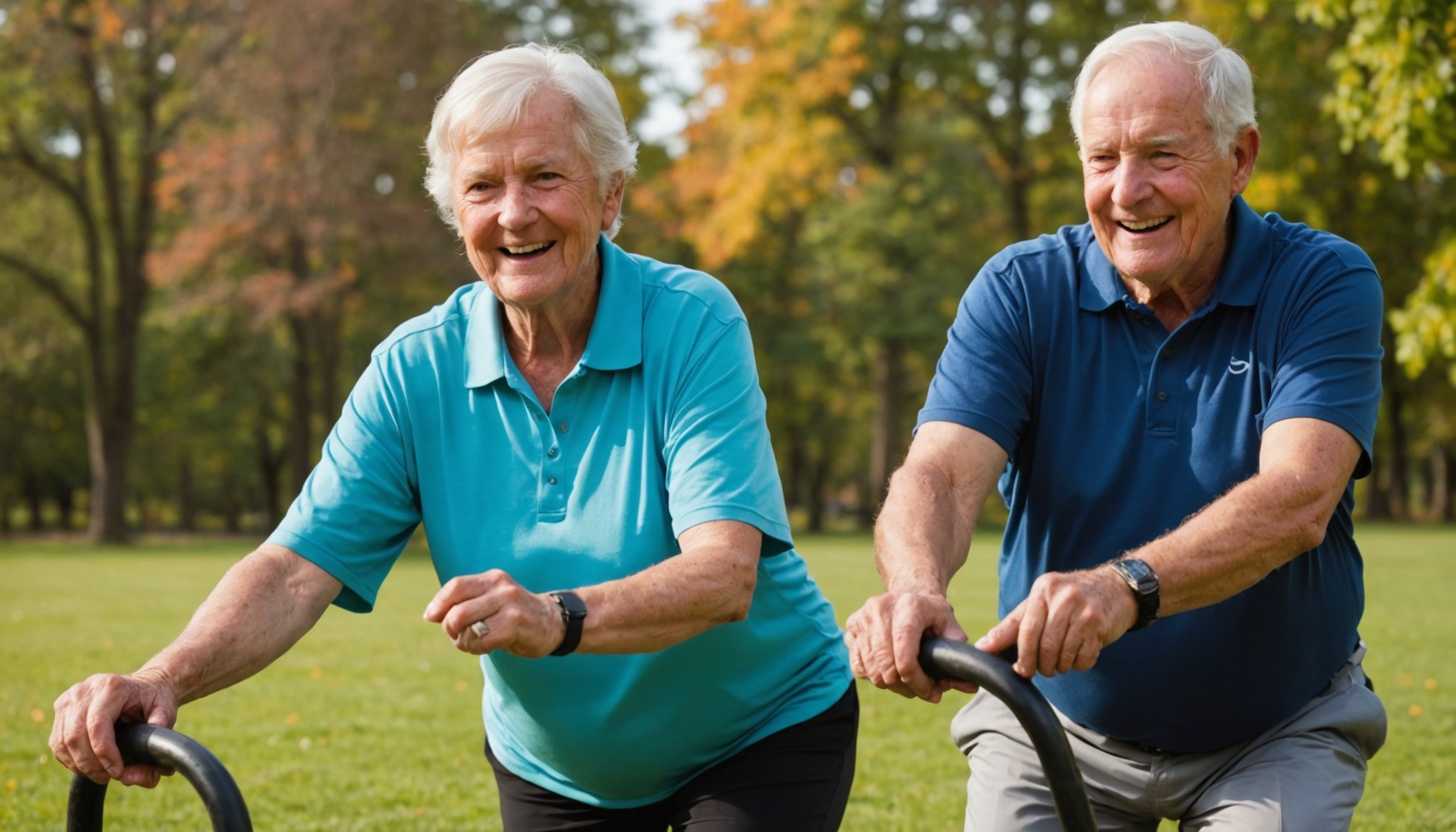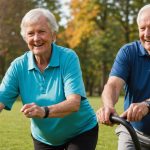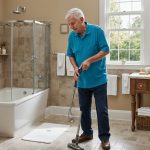Understanding Functional Fitness for Seniors
Functional fitness targets exercises that mimic daily activities seniors engage in, promoting strength, flexibility, and balance. This fitness approach ensures seniors have the capacity to manage everyday tasks safely and independently. Particularly beneficial to senior health enhancement, it focuses on preparing the body to perform activities like lifting, bending, or standing, which are crucial for maintaining autonomy.
As we age, natural physical changes occur, such as reduced muscle mass and joint flexibility, which can impact overall fitness levels. Functional fitness for seniors directly addresses these challenges by incorporating exercises that enhance mobility, stability, and functional strength. For instance, routines might include squats or gentle resistance training, which help improve muscle function and support everyday activities.
In parallel : Boosting Brain Health: The Role of Social Engagement in Preventing Cognitive Decline for Seniors Aged 70 and Above
The benefits of functional fitness extend beyond just physical health. By improving balance and strength, it reduces the risk of falls, a common concern for seniors. Furthermore, this fitness regimen can boost overall well-being by enhancing confidence and independence. Embracing functional fitness is more than just exercise; it’s about empowering seniors to live actively and maintain their quality of life.
Key Functional Fitness Exercises
To maintain independence and enhance overall health, incorporating functional exercises for seniors into daily routines is essential. These targeted exercises can significantly improve balance, strength, flexibility, and mobility.
In the same genre : Essential Bathroom Modifications for Seniors Over 75: Ensuring Safety and Fall Prevention
Balance and Stability Exercises
Improving balance is crucial for fall prevention, a common concern among seniors. Simple exercises can help enhance stability, such as:
- Standing on one leg: This aids in strengthening the leg and core muscles.
- Heel-to-toe walk: Ideally on a line or narrow path, this improves coordination.
When practising these senior exercise routines, ensure a stable environment: use a supportive chair or a wall to aid balance if needed.
Strength Training
Maintaining muscle strength is vital for daily activities. Engaging in simple strength training exercises can be beneficial. Examples include:
- Chair squats: These reinforce leg muscles.
- Wall push-ups: Convenient and require no equipment.
Safety precautions are crucial. Begin with a warm-up and consider lighter resistance for injury prevention. Consistency is key in safe exercises.
Flexibility and Mobility Workouts
Flexibility aids in maintaining independence by ensuring a full range of movement. Recommended stretches include:
- Toe touches: These stretch the back and leg muscles.
- Neck stretches: Enhancing upper body mobility.
Incorporating these into senior exercise routines might involve simple adjustments, like stretching during TV commercials or after walks.
Safety Guidelines for Senior Fitness
Incorporating exercise into daily routines can be transformative, yet maintaining senior fitness safety is paramount. One fundamental safety tip is to consult healthcare providers prior to embarking on any new exercise regimen. Healthcare professionals can tailor advice, ensuring any underlying conditions are considered and minimised risk of injury.
When exercising—whether leisurely at home or energetically with a group—adhering to core exercise safety tips enhances both experience and outcomes. Essentials include structured warm-ups and cool-downs, choosing activities like walking or swimming that suit individual capabilities, and continuously monitoring one’s own comfort levels.
Recognising the subtle cues of overexertion is crucial to sustaining health and comfort. Feeling dizzy, breathless, or experiencing sharp pain are signals to reduce efforts. Responding promptly by resting and rehydrating helps prevent exacerbating potential injuries. Moreover, knowing when to seek medical attention if discomfort persists, facilitates timely injury prevention.
Staying informed about exercise techniques and listening to one’s body empowers seniors to enjoy fitness while minimising potential risks. Embracing these principles ensures activities are not only safe but also enjoyable and rewarding.
Nutrition for Active Seniors
As individuals age, maintaining a balanced diet becomes crucial to support both fitness and overall health. For seniors, incorporating nutrition tailored to their specific needs is essential to sustain an active lifestyle.
Essential Nutrients
Seniors should focus on consuming nutrient-rich foods that support bone health, muscle function, and energy levels. Key nutrients include:
- Calcium and Vitamin D: Essential for maintaining bone density and preventing osteoporosis.
- Protein: Important for muscle repair and maintenance, helping to preserve muscle mass.
- Omega-3 Fatty Acids: Vital for heart health and reducing inflammation.
- Fibre: Aids in digestion and helps maintain healthy cholesterol levels.
Meal Planning Tips
Creating a well-rounded meal plan can ensure seniors receive the necessary nutrients. Here are a few dietary tips for seniors:
- Incorporate a variety of fruits and vegetables for essential vitamins and minerals.
- Choose whole grains over refined options for sustained energy and improved digestive health.
- Balance meals with lean proteins and healthy fats for a complete nutritional profile.
Importance of Hydration
Hydration plays a crucial role in maintaining physical activity and preventing dehydration. Seniors should aim to drink water regularly throughout the day, as adequate hydration improves cognitive function, reduces fatigue, and supports overall well-being.
Inspiring Success Stories
Inspiring senior fitness success stories often showcase how older adults have transformed their lives through dedication to health and exercise. Real-life examples abound, highlighting seniors who have gained independence and vitality. These stories frequently centre on individuals who have overcome physical limitations or health issues, spurred by a desire to improve their quality of life.
Common themes in these testimonials reveal motivation for seniors as being deeply personal, often tied to regaining lost mobility or maintaining social connections. Many seniors find motivation in the simple joys of being able to play with grandchildren, travel without restriction, or perform daily tasks independently. This intrinsic motivation forms the bedrock of many success stories.
Moreover, community support plays a pivotal role. Seniors often thrive when they engage in group activities, where camaraderie and shared experiences provide encouragement. Communities, whether they form in-person or online, offer a supportive environment where seniors can set and achieve fitness goals together. Success stories repeatedly affirm that encouragement and shared achievements boost morale and foster a positive outlook, making the journey to fitness more fulfilling and sustainable.
Resources and Tools for Seniors
In the digital age, the plethora of senior fitness resources available has grown significantly, offering innovative ways to stay active and healthy. Online platforms provide easy access to fitness apps for seniors which are designed with user-friendly interfaces. These apps often include customised workout plans focusing on balance, flexibility, and strength—key aspects of elderly wellness.
In addition to apps, local support groups are invaluable for senior fitness. They not only offer exercise classes but also create a sense of community, which is crucial for maintaining motivation. Many of these groups organise activities that are both engaging and tailored to various fitness levels, ensuring that all members have the opportunity to participate.
Social interaction is a fundamental motivator for many seniors. Support networks, whether virtual or physical, can encourage consistent engagement and foster a sense of accountability. This interactive element, often found through group challenges or coordinated exercise events, plays a vital role in sustaining interest and dedication to fitness routines.
Staying fit as a senior doesn’t have to be a solitary journey; leveraging both online resources and community-based support can enhance overall well-being and provide a comprehensive approach to health.











